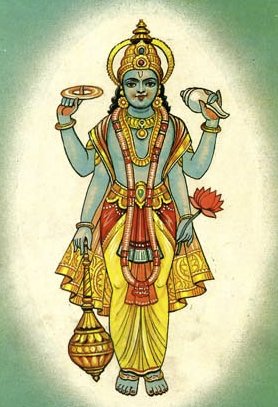Parantapa, Para-tapa, Pārantapa, Paramtapa: 6 definitions
Introduction:
Parantapa means something in Buddhism, Pali, Hinduism, Sanskrit. If you want to know the exact meaning, history, etymology or English translation of this term then check out the descriptions on this page. Add your comment or reference to a book if you want to contribute to this summary article.
In Hinduism
Vaishnavism (Vaishava dharma)
Source: Pure Bhakti: Bhagavad-gita (4th edition)Parantapa (परन्तप) refers to “‘Chastiser of the enemy’, Arjuna”. (cf. Glossary page from Śrīmad-Bhagavad-Gītā).

Vaishnava (वैष्णव, vaiṣṇava) or vaishnavism (vaiṣṇavism) represents a tradition of Hinduism worshipping Vishnu as the supreme Lord. Similar to the Shaktism and Shaivism traditions, Vaishnavism also developed as an individual movement, famous for its exposition of the dashavatara (‘ten avatars of Vishnu’).
In Buddhism
Theravada (major branch of Buddhism)
Source: Pali Kanon: Pali Proper Names1. Parantapa
King of Kosambi and father of Udena. DhA.i.164.
2. ParantapaAn attendant of the king of Benares. For his story see the Parantapa Jataka.
Theravāda is a major branch of Buddhism having the the Pali canon (tipitaka) as their canonical literature, which includes the vinaya-pitaka (monastic rules), the sutta-pitaka (Buddhist sermons) and the abhidhamma-pitaka (philosophy and psychology).
Languages of India and abroad
Sanskrit dictionary
Source: Cologne Digital Sanskrit Dictionaries: Shabda-Sagara Sanskrit-English DictionaryParantapa (परन्तप).—mfn.
(-paḥ-pā-paṃ) Vexing or annoying another, subduing a foe. m.
(-paḥ) A conqueror. E. para another, tapa to heat or inflame, aff. khac .
Source: Cologne Digital Sanskrit Dictionaries: Yates Sanskrit-English DictionaryParantapa (परन्तप):—[para-ntapa] (paḥ-pā-paṃ) a. Vexing or annoying another. m. Conqueror.
Sanskrit, also spelled संस्कृतम् (saṃskṛtam), is an ancient language of India commonly seen as the grandmother of the Indo-European language family (even English!). Closely allied with Prakrit and Pali, Sanskrit is more exhaustive in both grammar and terms and has the most extensive collection of literature in the world, greatly surpassing its sister-languages Greek and Latin.
Pali-English dictionary
Source: Sutta: The Pali Text Society's Pali-English DictionaryPārantapa: worrying or molesting another person (opp. attantapa) D. III, 232; M. I, 341, 411; II, 159; Pug. 56.

Pali is the language of the Tipiṭaka, which is the sacred canon of Theravāda Buddhism and contains much of the Buddha’s speech. Closeley related to Sanskrit, both languages are used interchangeably between religions.
Kannada-English dictionary
Source: Alar: Kannada-English corpusParaṃtapa (ಪರಂತಪ):—[adjective] vexing one’s enemies.
--- OR ---
Paraṃtapa (ಪರಂತಪ):—
1) [noun] he who vexes his enemies; a hero.
2) [noun] one of the appellation of Arjuna, the hero in Mahābhārata, the great Indian epic.
Kannada is a Dravidian language (as opposed to the Indo-European language family) mainly spoken in the southwestern region of India.
See also (Relevant definitions)
Starts with: Paramtapana, Parantapabbata, Parantapan.
Full-text (+13): Paramtapa, Magadheshvara, Paramtapana, Parantap, Daurbala, Daurbalya, Ashraddadhana, Tapa, Dyuti, Tapodhana, Sutapa, Tapasya, Tapomula, Kalmasha, Dhanvin, Taparati, Tanvi, Lekhya, Abhishecya, Vamsha.
Relevant text
Search found 29 books and stories containing Parantapa, Para-tapa, Pārantapa, Paramtapa, Pāra-tapa, Para-ntapa, Paraṃtapa; (plurals include: Parantapas, tapas, Pārantapas, Paramtapas, ntapas, Paraṃtapas). You can also click to the full overview containing English textual excerpts. Below are direct links for the most relevant articles:
Shrimad Bhagavad-gita (by Narayana Gosvami)
Verse 2.9 < [Chapter 2 - Sāṅkhya-yoga (Yoga through distinguishing the Soul from the Body)]
Verse 4.2 < [Chapter 4 - Jñāna-Yoga (Yoga through Transcendental Knowledge)]
Verse 10.40 < [Chapter 10 - Vibhūti-yoga (appreciating the opulences of the Supreme Lord)]
Gitartha Samgraha (critical Study) (by Partha Sarathi Sil)
9. Variations in Ślokas < [Chapter 4 - Critical Study of the Gītārthasaṅgraha]
The Jataka tales [English], Volume 1-6 (by Robert Chalmers)
Jataka 416: Parantapa-jātaka < [Volume 3]
Garga Samhita (English) (by Danavir Goswami)
Verse 6.9.27 < [Chapter 9 - The Arrival of Śrī Dvārakā]
The Skanda Purana (by G. V. Tagare)
Chapter 277 - In Praise of Dāna Performed in front of Rudras < [Section 1 - Tīrtha-māhātmya]
Chapter 58 - The Procedure of Śrāddha < [Section 1 - Avantīkṣetra-māhātmya]
Chapter 107 - Procedure of the Worship of Brahmā < [Section 1 - Prabhāsa-kṣetra-māhātmya]
Yoga-sutras (Ancient and Modern Interpretations) (by Makarand Gopal Newalkar)
Sūtra 2.39 < [Book II - Sādhana-pāda]